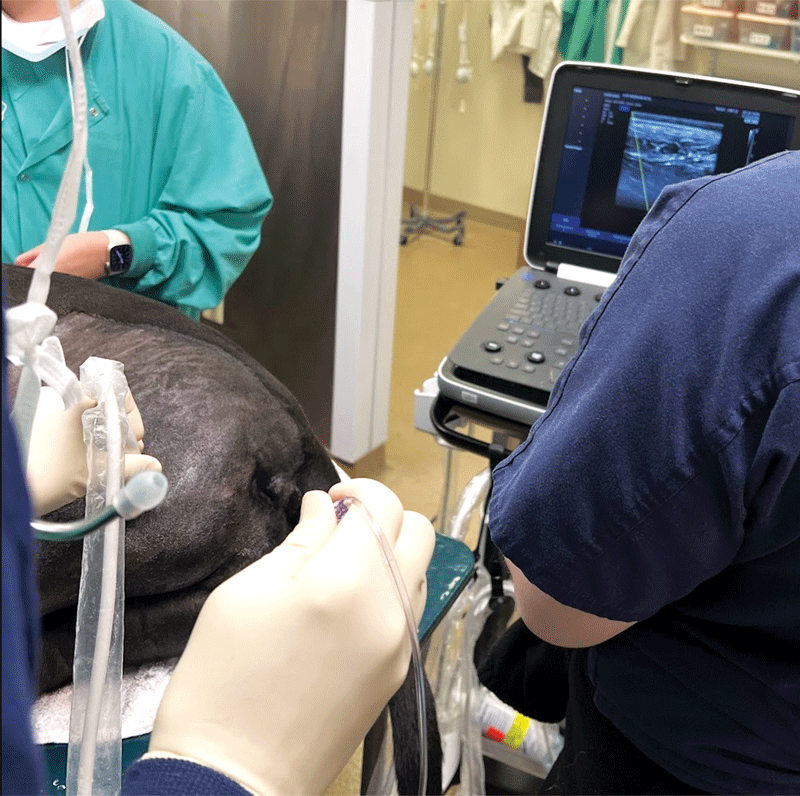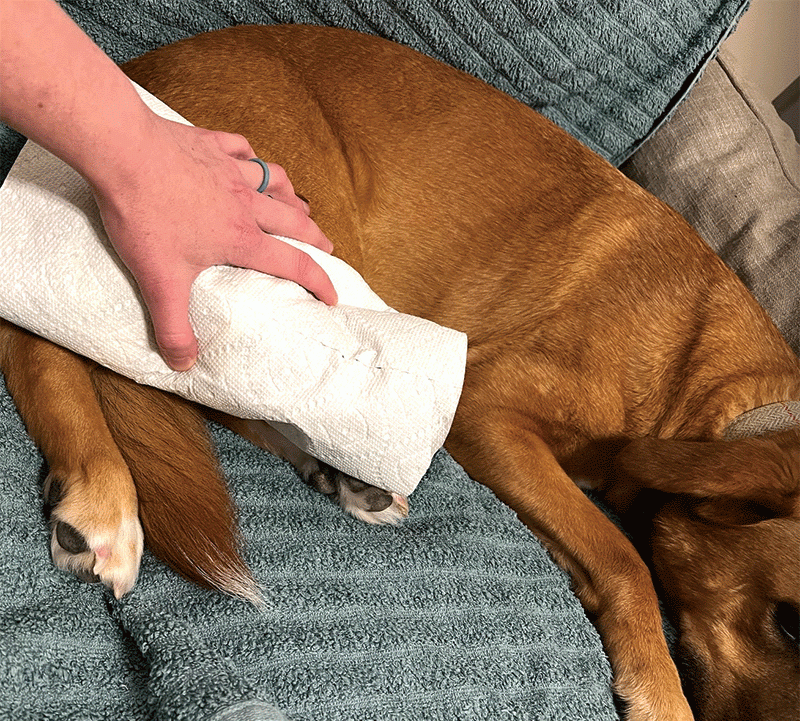I firmly believe analgesia leads to improved patient outcomes with early return to weight bearing after orthopedic surgery, allowing the patient to maintain muscle mass, joint range of motion, and overall mobility. Below I will highlight some of the analgesic techniques our clinic commonly uses in the perioperative period.
Opioids are commonly used in the surgical patients at our clinic. Although opioids are commonly associated with some undesirable side effects, such as gastrointestinal stasis, urinary retention, and dysphoria, the use of multimodal analgesia allows the dose of opioids to be kept as low as possible to maximize the analgesic effects while lowering side effects. Pain relief should go well beyond drugs alone, though. Reducing swelling and bruising will help limit pain in the first week postoperatively, and strategies to help reduce muscle soreness and joint stiffness will improve your patients’ short- to medium-term outcome. While veterinary patients are exceptionally resilient and are frequently mobile within 24 hours of major surgery, providing additional physiotherapy assistance can substantially improve their postoperative mobility.
Minimizing complications is also important to reducing pain in our patients. Therefore, Elizabethan collars, leg covers, bandages, and other devices to prevent patient interference with the surgical site are also important tools to help in the perioperative period. They should be considered as important to write on the treatment sheet as the opioid medication.
Local anesthetic
Local anesthetics work by a dose-dependent blockade of afferent nerve sodium channels inhibiting transmission and preventing pain. Regional nerve blocks are very effective for appendicular perioperative analgesia. Using ultrasound or a nerve stimulator is recommended to allow infiltration of the local anesthetic around the desired nerve (Figure 1). It often requires training to be able to successfully identify the correct nerve with ultrasound, but there are several continuing education courses available.
Following a course, it can be helpful to practice using a cadaver and methylene blue to identify how close you are to the desired area. An epidural is technically easier to perform than an ultrasound-guided nerve block for pelvic limb procedures; however, using a local nerve block avoids some potential undesirable postoperative issues, such as urinary retention, and allows the patient to ambulate using their other three legs.

We have seen in our patients the ability to ambulate soon after surgery reduces their stress and helps prevent gastrointestinal stasis.
Successful local nerve blocks can last for 24 hours and help reduce the dose of opioids required postoperatively, therefore reducing opioid side effects.
Surgical technique
Gentle tissue handling is one of the core principles of surgery,1 and it should not be overlooked as a mechanism for reducing pain in our patients.
Correct use of atraumatic instruments, such as DeBakey thumb forceps, the gentle use of retractors to allow visualization without overstretching of tissues and limiting dissection to just enough to allow access to the desired surgical site, are all important techniques for reducing pain in our surgical patients.
Avoiding the use of monopolar cautery for skin incisions and instead using a scalpel will reduce pain by reducing inflammation and the incidence of wound complications and accelerating wound healing.2 After incising the skin, cautery can be used to help reduce blood loss. This will help reduce postoperative swelling, but care should be taken to avoid too much collateral tissue damage.
Limiting soft tissue dissection to reduce perioperative pain can also be done through minimally invasive techniques (i.e. arthroscopy, laparoscopy, and thoracoscopy). For example, laparoscopic ovariectomy reduces postoperative pain compared to open ovariectomy.3 In my experience, how quickly our patients recover from minimally invasive procedures can be quite remarkable. Often, the challenge after such surgeries is keeping the patient calm enough to allow the small incisions to heal.
Icing/heat/compression
Cold compression therapy has been shown to reduce postoperative pain in the first 24 hours postoperatively after tibial plateau leveling osteotomy.4 There are veterinary-specific devices commercially available that concurrently provide both ice and compression. The compression can be a little uncomfortable for awake patients, though, and should not be persevered with if this is the case. An ice pack alone will provide cold therapy to the area, which is not as effective as combining with compression, but will temporarily numb the area and provide analgesia.
To prevent injury to the patient, the cold pack should be wrapped in a thin towel (Figure 2). Dampening the towel can accelerate the transfer of temperature but is often not desirable when a surgical incision is present.

Heat therapy can be particularly helpful in reducing pain from muscle spasms, lengthening tight muscles, and relaxing joint capsules and tendons.5 Heat also helps reduce post-operative oedema and bruising. We often transition our patients from cold therapy to heat therapy three to four days postoperatively.
Physiotherapy
Physiotherapy includes massage, range of motion exercises, acupuncture, laser treatment, and electromagnetic therapy. All of these may provide some degree of analgesia to patients postoperatively, and having a veterinary physiotherapist involved in the postoperative care of surgical patients will aid in their recovery.
Incorporation of early physiotherapy after TPLO surgery in dogs has been shown to improve thigh musculature and stifle range of motion at six weeks postoperatively.6 Low-level laser therapy has not been shown to be effective at providing postoperative analgesia but may aid in wound healing and therefore might help reduce the potential for wound complications.7 Acupuncture can work well in some patients and can even be used to help reduce inpatient anxiety. As in humans, some animal patients have “needle phobia” and therefore the cases should be carefully selected and the acupuncture should be performed by a suitably qualified veterinarian. Comfortable harnesses with sturdy handles to help aid the patient rising from laying down and ambulating will also help prevent soreness, stiffness, and dependent edema.
Jessica McCarthy, BVSc, MRCVS, DECVS, works as an associate teaching professor in small animal orthopedic surgery at the University of Missouri. She became a diplomat of the European College of Veterinary Surgeons in 2020 after completing her residency training at the University of Edinburgh. Dr. McCarthy attended Bristol University for her veterinary degree and spent two years in general practice in England after graduating. She has a particular interest in elbow disease, both developmental and traumatic. McCarthy is passionate about ensuring everyone in the veterinary profession can work in a diverse and inclusive atmosphere.
References
- Johnston SA, Tobias KM. Veterinary Surgery: Small Animal Expert Consult-E-Book. Elsevier Health Sciences; 2017.
- Scott JE, Swanson EA, Cooley J, Wills RW, Pearce EC. Healing of canine skin incisions made with monopolar electrosurgery versus scalpel blade. Vet Surg. 2017 May;46(4):520–9.
- Fuertes-Recuero M, de Segura IAG, López AS, Suárez-Redondo M, Arrabé SC, Hidalgo SP, et al. Postoperative pain in dogs undergoing either laparoscopic or open ovariectomy. The Veterinary Journal. 2024 Aug;306:106156.
- Drygas KA, McClure SR, Goring RL, Pozzi A, Robertson SA, Wang C. Effect of cold compression therapy on postoperative pain, swelling, range of motion, and lameness after tibial plateau leveling osteotomy in dogs. J Am Vet Med Assoc. 2011 May 15;238(10):1284–91.
- Dragone L, Heinrichs K, Levine D, Tucker T, Millis D. Superficial Thermal Modalities. Canine rehabilitation and physical therapy. Elsevier; 2014. p. 312–27.
- Monk ML, Preston CA, McGowan CM. Effects of early intensive postoperative physiotherapy on limb function after tibial plateau leveling osteotomy in dogs with deficiency of the cranial cruciate ligament. Am J Vet Res. 2006 Mar;67(3):529–36.
- Kennedy KC, Martinez SA, Martinez SE, Tucker RL, Davies NM. Effects of low-level laser therapy on bone healing and signs of pain in dogs following tibial plateau leveling osteotomy. Am J Vet Res. 2018 Aug;79(8):893–904.
